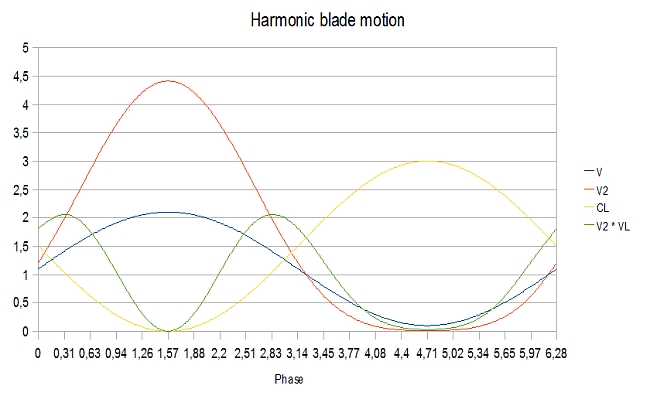Harmonic Blade Motion and Vibration
In the last section (Rotordisc and Forward Flight) we found that in forward flight, lift distribution is not
symmetrical across the rotordisc. This asymetry must be compensated for by applying corrective
cyclic control. We will now look at this situation in more detail and show that
the blades are contineously subjected to an oscillating force due to aerodynamical
lift which changes with angular phase. This oscillating force, in combination with the properties of the
blades itself, leads to blade vibrations. Every helicopter suffers form this phenomenon.
In the image below, the lift function, as an element of phase angle, is derived
for a helicopter in forward flight. The key formula is the
Lift function Flift = CL
(1/2) ρ V2 S, and,
as can be seen, we must look at the product of the airspeed squared and the lift
coefficient for each phase angle. The first 2 graphs denote V and V2 (in blue and red), while the third shows
the CL for each phase angle
(yellow). The CL depends
upon the angle of attack, which is defined by cyclic input. Note that this is the
cyclic input which must be applied by the pilot to compensate for the effects of
asymmetrical lift during forward flight. The result is shown in the final graph
(green), where it is seen that each blade will encounter an Flift that varies within each revolution
with something that looks like a distorted sinus function. Because of this ('distorted'
sinus function), several higher order harmonics (especially the third and the fifth
) exist.

There are several effects of this oscillating Flift. The first is that the blades continuously wave in and out of the (tilted) cone (blade flapping). Secondly, the Flift
function drives several blade vibration modes which depend upon a number of factors,
such as the damping of the
blade, stiffness due to centrifugal forces, shape, etc.
As a result, the thrust that is generated to the mast is not constant, but is
modulated by the
flapping action and blade vibrations. This can be felt in the helicopter as vibrations.
The
type and precise design of the rotor head have a major influence on the extent of the vibrations that are transmitted to the shaft.
|
Helicopter Theory (Paperback)
- This enormous tome provides comprehensive and detailed coverage of every aspect of helicopter theory. The purpose of the
book is to set out for the reader the engineering analyses required to enable the successful design of a rotorcraft. All relevant subjects,
such as vertical flight, forward flight, performance, rotating systems, rotary wing dynamics, aerodynamics and aero elasticity,
and stability and control are covered. They are explained at an in depth engineering level, always accompanied by accurate
mathematical analyses. A good knowledge of mathematics and a degree in engineering are necessary, as these topics are dealt with
extensively throughout the text.
- 1089 pages.
|
|
Principles of Helicopter Aerodynamics (Cambridge Aerospace Series) (Hardback)
- Modern treatment of the aerodynamic principles of helicopters and rotating-wing vertical lift aircraft
- Uses mathematics throughout the text
- Concepts are derived from basic enginering principals
- 864 pages
|
Comments are disabled.